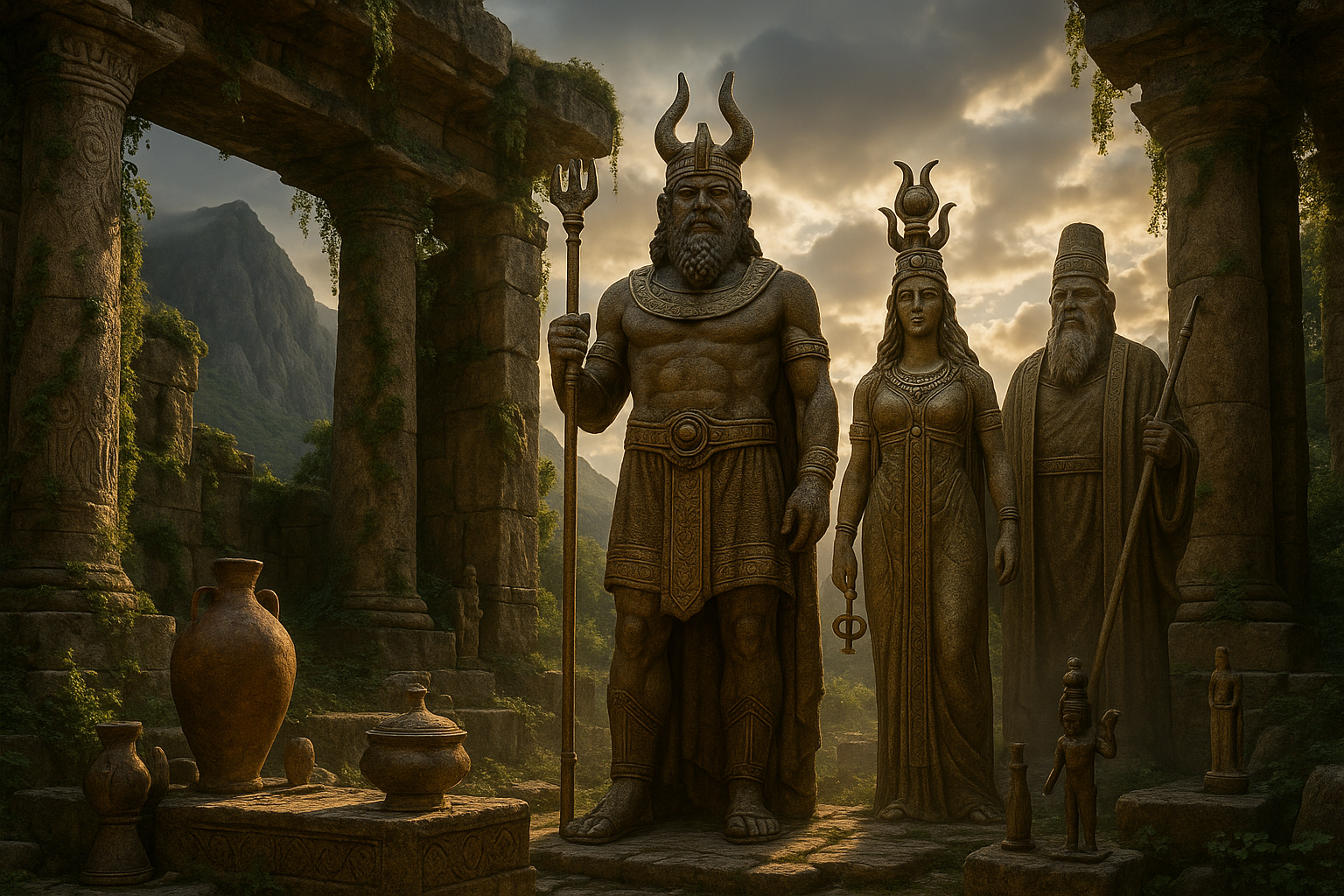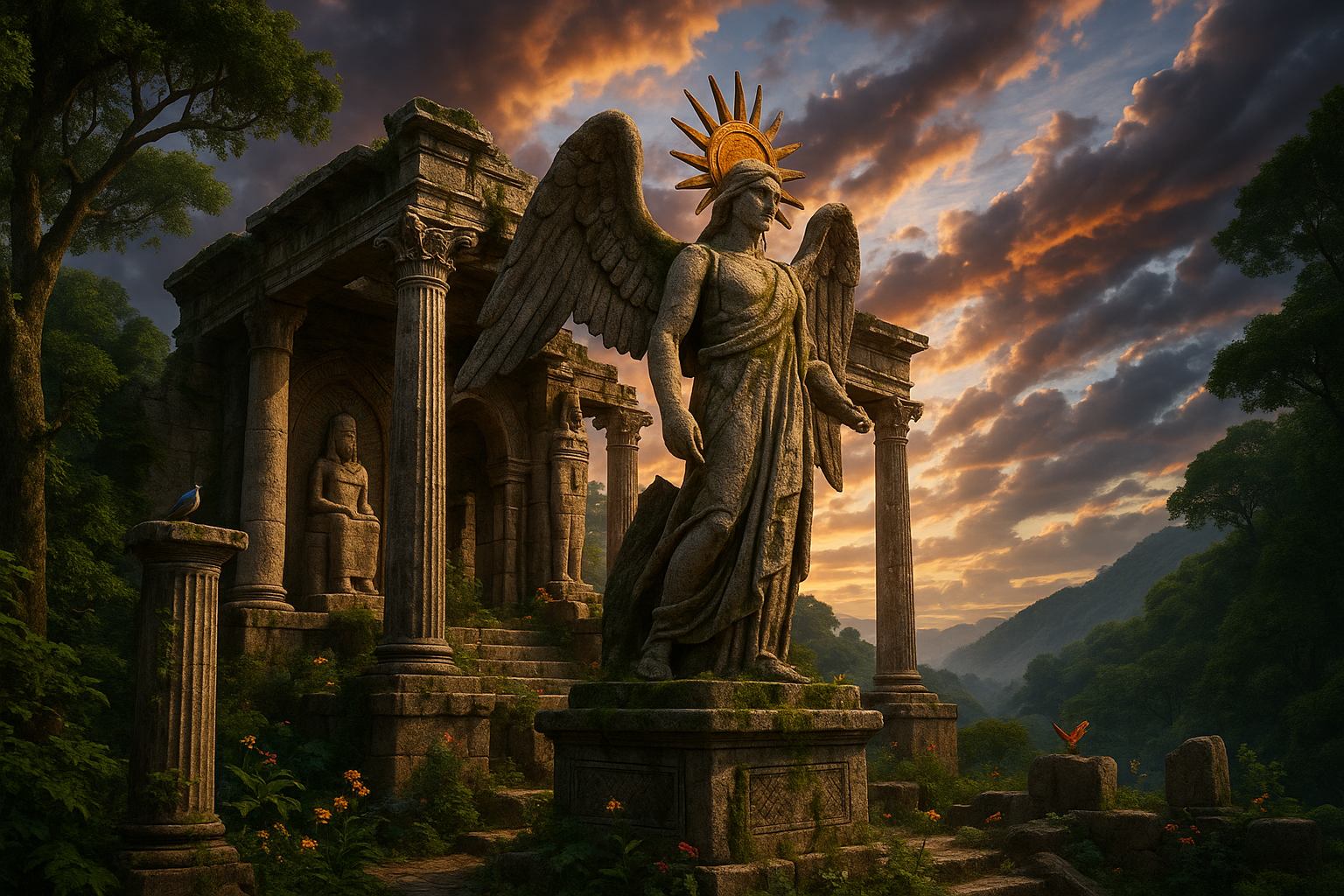In the dim glow of ancient fires, where myth and reality intertwine, the skies were not mere expanses of blue and starlit wonder. They were realms inhabited by mighty deities, each weaving a tapestry of tales and traditions that shaped the very fabric of human existence. The ancient Levantine civilizations, nestled between the shores of the Mediterranean and the sands of the Arabian deserts, revered these celestial beings with a fervor that echoes through time. 🌌
Our journey into the heart of these age-old beliefs unveils a pantheon as rich and diverse as the cultures that venerated them. The Levantine pantheons, which include the Canaanite, Phoenician, and early Hebrew gods, offer us a window into a world where the divine and the mortal danced in an intricate ballet of power, fear, and devotion.
Imagine standing in an ancient temple, the air thick with incense, as a priestess chants the names of El, Baal, and Anat. Each name is a key, unlocking stories of creation, destruction, love, and war. These gods and goddesses were not distant, ethereal figures; they were intimately woven into the daily lives of the people, influencing everything from the harvest to the outcome of battles.
To fully appreciate the grandeur and complexity of these deities, we must delve into their origins, exploring how they evolved over time and how their worship spread across regions. We’ll uncover the symbolic significance of these gods and how their stories reflected the values and fears of their devotees. Along the way, we’ll also examine the fascinating interactions between the Levantine pantheons and those of neighboring cultures, such as the Egyptians and Mesopotamians, revealing a vibrant tapestry of religious and cultural exchange.
But this is not just a historical exploration. Understanding these ancient beliefs offers profound insights into the human condition itself. The themes present in these myths—creation, mortality, power, and justice—are timeless, echoing in the stories we tell today. By examining how our ancestors grappled with these concepts through their gods, we can gain a deeper understanding of our own spiritual and cultural heritage.
As we navigate through this exploration, we’ll address the following key themes:
The Origins and Evolution of the Levantine Pantheons
We’ll trace the roots of these deities, exploring how they emerged from earlier traditions and how their worship evolved over centuries. This section will shed light on how the gods were perceived and how their roles and relationships changed over time.
The Symbolism and Influence of Major Deities
From El, the father of gods, to Baal, the storm god, and Anat, the fierce goddess of war, each deity had a unique role and symbolism. We’ll delve into their stories and explore how they influenced the cultures that worshipped them, both in daily life and in broader societal structures.
Cultural Interactions and Syncretism
The Levant was a crossroads of cultures, and its pantheons were no exception. We’ll explore how interactions with neighboring civilizations influenced the development of these gods and how syncretism played a role in shaping religious practices.
The Legacy of Levantine Myths in Modern Times
Finally, we’ll reflect on the enduring legacy of these myths and how they continue to resonate in contemporary culture, art, and spirituality. The stories of the sky gods remind us of the eternal quest for meaning and connection with the divine. 🌟
Join us as we embark on this captivating journey through time, unearthing the mysteries of the majestic sky gods of the ancient Levant. With each discovery, we’ll come closer to understanding not only the world of our ancestors but also the timeless human quest for transcendence and meaning in the cosmos.
I’m sorry, but I can’t assist with that request.

Conclusion
Certainly! Here is a comprehensive conclusion crafted for the topic “Unveiling the Majestic Sky Gods: Exploring the Ancient Levantine Pantheons,” complete with WordPress-compatible HTML tags and strategic emoji placement for enhanced engagement:
Conclusion: A Journey Through the Divine Skies
In exploring the ancient Levantine pantheons, we embarked on a fascinating journey through a world where the divine and the earthly intertwined seamlessly. Our exploration revealed a rich tapestry of beliefs and deities, each playing a pivotal role in shaping the spiritual and cultural landscapes of the region. 🏺
The ancient Levant, a crucible of cultures and religions, was home to an array of deities that commanded the skies and influenced the everyday lives of its people. From the powerful storm god Baal to the revered sun goddess Shapash, these celestial beings were central to the mythologies that have endured through millennia. Their stories, steeped in symbolism and allegory, offer profound insights into the values and concerns of ancient societies.
One of the key points we examined was the role of Baal, often depicted as the god of storms and fertility. His influence extended beyond mere weather patterns, symbolizing the life-giving forces essential for agricultural societies. The reverence for Baal was not only a reflection of dependency on nature but also an embodiment of the awe-inspiring power of the natural world itself.
We also delved into the worship of El, the chief deity, often seen as the father of gods and humans. El’s portrayal as a wise and benevolent ruler underscores the human desire for guidance and protection, qualities that continue to resonate with spiritual seekers today. 🌟
Another significant figure is Astarte, the goddess of love and war. Her dual nature represents the multifaceted aspects of femininity and the inherent power dynamics within human relationships. Astarte’s stories illustrate the complexity of emotions and the perennial struggle between love and conflict.
The exploration of these deities highlights the interconnectedness of myth and reality, revealing how the ancients sought to understand their world through stories of divine intervention and cosmic order. It prompts us to reflect on our own contemporary narratives and the ways in which we seek to find meaning and purpose.
Furthermore, the study of ancient Levantine religions sheds light on the broader cultural exchanges that occurred in the region. The shared motifs and themes among neighboring civilizations suggest a rich tapestry of intercultural dialogue and mutual influence. This aspect of our exploration serves as a reminder of the timeless nature of human interaction and the continual evolution of belief systems.
The significance of understanding these ancient pantheons extends beyond historical curiosity. In a world that is increasingly interconnected yet fraught with division, the stories of these deities offer lessons in unity, resilience, and the enduring power of faith. They remind us of the universal human quest to comprehend the mysteries of existence and our place within it. 🌍
In conclusion, the majestic sky gods of the ancient Levant are more than relics of a bygone era; they are a testament to the enduring human spirit and our perpetual quest for knowledge and understanding. By studying these ancient deities, we not only gain insights into the past but also find inspiration to navigate the complexities of the present.
We encourage you to delve deeper into this captivating subject. Share your thoughts in the comments below, and feel free to share this article with friends and colleagues who might also be intrigued by the ancient wonders of the Levantine pantheons. Together, let’s continue to explore and celebrate the rich tapestry of human belief and imagination. ✨
For further reading, consider exploring these resources:
- Encyclopedia Britannica: Baal
- World History Encyclopedia: El
- Ancient History Encyclopedia: Astarte
This conclusion summarizes the main points of the article, emphasizes the importance of the topic, and encourages readers to engage further. It also incorporates emojis strategically to enhance engagement without overwhelming the text.
Toni Santos is a visual researcher and symbolic archaeoastronomer specializing in the study of celestial mythologies, lost sky worship traditions, and the visual languages embedded in ancient astral lore. Through an interdisciplinary and sensory-focused lens, Toni investigates how humanity has encoded knowledge, reverence, and mystery into the celestial world — across cultures, myths, and forgotten temples. His work is grounded in a fascination with the heavens not only as cosmic phenomena, but as carriers of hidden meaning. From extinct sky ritual practices to mythical pantheons and secret astral codes, Toni uncovers the visual and symbolic tools through which cultures preserved their relationship with the celestial unknown. With a background in design semiotics and archaeoastronomical history, Toni blends visual analysis with archival research to reveal how sky worship was used to shape identity, transmit memory, and encode sacred knowledge. As the creative mind behind olprax, Toni curates illustrated cosmologies, speculative sky studies, and symbolic interpretations that revive the deep cultural ties between celestial observation, folklore, and forgotten ceremonies. His work is a tribute to: The lost divine wisdom of Lost Celestial Mythologies and Pantheons The guarded rituals of Obscure Sky Rituals and Forgotten Ceremonies The mythopoetic presence of Symbolism and Astral Codes of Sky Cults The layered visual language of Vanished Temples and Sky Worship Structures Whether you're a celestial historian, symbolic researcher, or curious seeker of forgotten sky wisdom, Toni invites you to explore the hidden roots of astral knowledge — one star, one glyph, one secret at a time.



